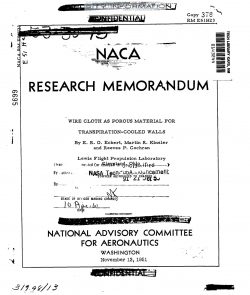naca-rm-e51h23
- Version
- 124 Downloads
- 1.39 MB File Size
- 1 File Count
- May 25, 2017 Create Date
- May 25, 2017 Last Updated
National Advisory Committee for Aeronautics, Research Memorandum - Wire Cloth as a Porous Material for Transpiration Cooled Walls

An investigation was made to determine the properties of wire cloth
as a porous material for transpiration—cooled walls where a coolant is
forced through the porous material to.form an insulating layer of fluid
on the heated surface of the wall. Materials presently available for
transpiration cooling, such as sintered.porous metals, do not have suf-
ficient strength for applications in which the operating stresses are
high. For applications where the stresses act primarily in_one direc-
tion, a porous material with high strength in that direction is desirable.
An example of such an application is in turbine-rotor blades where the
centrifugal stress predominates. The suitability of a corduroy-type wire
cloth manufactured from AISI type 304 stainless steel was investigated
for this purpose.
The cloth was woven with considerably more wires in one direction
than in the other. As woven, the cloth was too permeable for most .
transpiration-cooling applications, but by cold-rolling a porous material
may be obtained with a wide range of permeabilities, which should cover
most requirements for transpiration-cooled walls. The stiffness of the
wire cloth could be increased by a brazing process that bonded the wires
together. In order to provide an adequate basis for comparison of
various porous materials, a reduced tensile strength was introduced for
aircraft applications where strength-density ratio is important. The
reduced tensile strength of the cloth after brazing and rolling was as
high as 150,000 pounds per square inch, which is_2 to 3 times the ulti-
mate comparable strength of compacted sintered.metals. Spot-welding was
found to be a satisfactory method of attaching wire cloth to solid struc-
tures and seam brazing afforded a means of attaching layers of cloth to
each other.
Transpiration cooling has been shown to be an effective means for
cooling structures in high-temperature high-velocity gas streams (refer-
ence 1). In the transpiration-cooling process, the walls of the struc-
ture are made of a porous material and a coolant is ferced through the
porous wall to form an insulating layer of fluid.between the wall and
the hot gas stream. This method holds particular promise for air-cooled
gas-turbine rotcrgblades where conventional_convectionacooling methods
become inadequate at high gas temperatures. The transpiration-cooling
method also offers attractive possibilities for the cooling of other
structural elements in the aircraft propulsion system, such as com-
bustion chambers, transition ducts, turbine stators and casings, and
Jet-nozzle components. This method may also be used to protect the skin
of missiles from aerodynamic heating effects. Additional applications
for porous walls may be found in deicing where wanm air is forced through
the walls, and in boundary-layer control devices where suction is applied
to improve flow characteristics.
| File | Action |
|---|---|
| naca-rm-e51h23 Wire Cloth as a Porous Material for Transpiration Cooled Walls.pdf | Download |

Comment On This Post